The Corsair MP400 1TB QLC NVMe SSD: A Quick Review
by Billy Tallis on December 11, 2020 2:00 PM ESTMixed IO Performance
Our tests of mixed read/write IO vary the workload from pure reads to pure writes at 10% increments. Each mix is tested for up to 1 minute or 32GB of data transferred. The mixed random IO test uses a queue depth of 4 while the mixed sequential IO test uses a queue depth of 1. The tests are confined to a 64GB span of the drive, and the drive is given up to one minute of idle time in between each mix tested.
 |
|||||||||
| Mixed Random IO | Mixed Sequential IO | ||||||||
The QLC NVMe drives like the Corsair MP400 have a clear advantage over the DRAMless TLC drives for mixed read/write workloads. This is particularly pronounced for the mixed random IO test, where the DRAMless TLC drives are even slower than the QLC SATA drive. On the mixed sequential IO test, those DRAMless TLC drives can compete with some of the slower QLC NVMe drives, but the 8-channel Phison E12 controller used in the Corsair MP400 and Sabrent Rocket Q helps them stay ahead as the faster budget NVMe strategy.
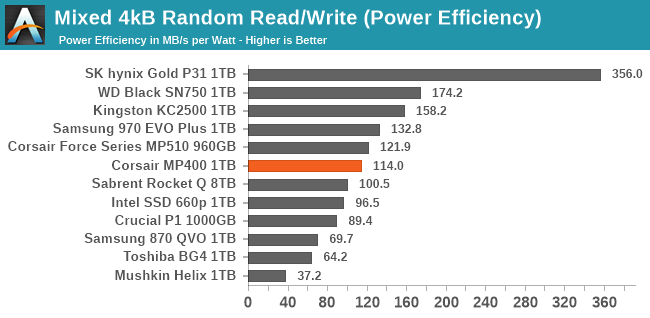 |
|||||||||
| Mixed Random IO | Mixed Sequential IO | ||||||||
The budget NVMe drives all have worse power efficiency during the mixed IO tests than any of the high-end options, but the Corsair MP400 has some of the best efficiency scores within the budget NVMe segment. The 8TB Sabrent Rocket Q trails behind the 1TB MP400 because of the extra power draw of so many NAND dies.
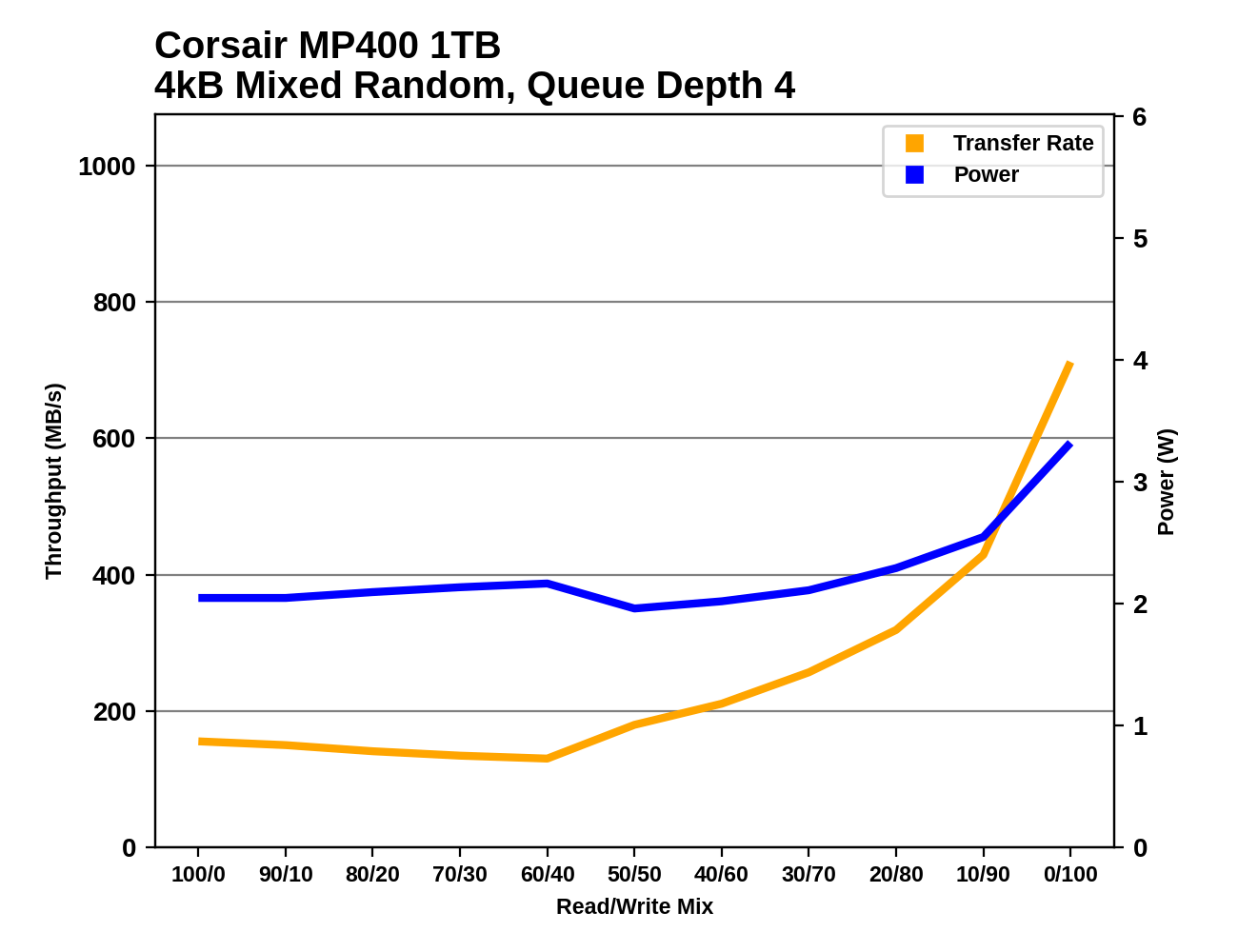 |
|||||||||
| Mixed Random IO | |||||||||
| Mixed Sequential IO | |||||||||
The Corsair MP400's performance curves through the mixed random and sequential IO tests generally resemble what we saw for the Sabrent Rocket Q. On the mixed sequential IO test, the 8TB Rocket Q generally maintained a clear performance lead over the 1TB MP400 (at the cost of much higher power draw), but their performance scaling across the random IO test is very similar. The overall shape of the performance curves for these QLC drives has a lot more in common with mainstream TLC drives than it does with the entry-level DRAMless TLC drives; the QLC drives are slower than mainstream TLC drives, but not as obviously limited as the DRAMless drives.
Idle Power Measurement
SATA SSDs are tested with SATA link power management disabled to measure their active idle power draw, and with it enabled for the deeper idle power consumption score and the idle wake-up latency test. Our testbed, like any ordinary desktop system, cannot trigger the deepest DevSleep idle state.
Idle power management for NVMe SSDs is far more complicated than for SATA SSDs. NVMe SSDs can support several different idle power states, and through the Autonomous Power State Transition (APST) feature the operating system can set a drive's policy for when to drop down to a lower power state. There is typically a tradeoff in that lower-power states take longer to enter and wake up from, so the choice about what power states to use may differ for desktop and notebooks, and depending on which NVMe driver is in use. Additionally, there are multiple degrees of PCIe link power savings possible through Active State Power Management (APSM).
We report three idle power measurements. Active idle is representative of a typical desktop, where none of the advanced PCIe link or NVMe power saving features are enabled and the drive is immediately ready to process new commands. Our Desktop Idle number represents what can usually be expected from a desktop system that is configured to enable SATA link power management, PCIe ASPM and NVMe APST, but where the lowest PCIe L1.2 link power states are not available. The Laptop Idle number represents the maximum power savings possible with all the NVMe and PCIe power management features in use—usually the default for a battery-powered system but rarely achievable on a desktop even after changing BIOS and OS settings. Since we don't have a way to enable SATA DevSleep on any of our testbeds, SATA drives are omitted from the Laptop Idle charts.
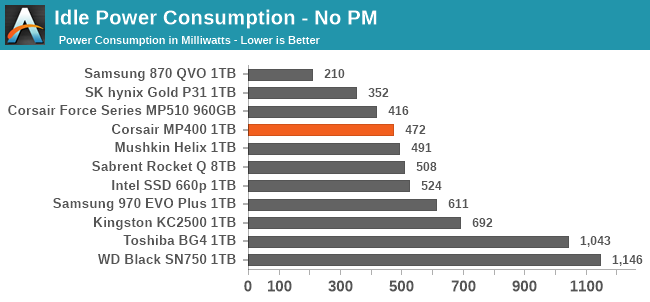
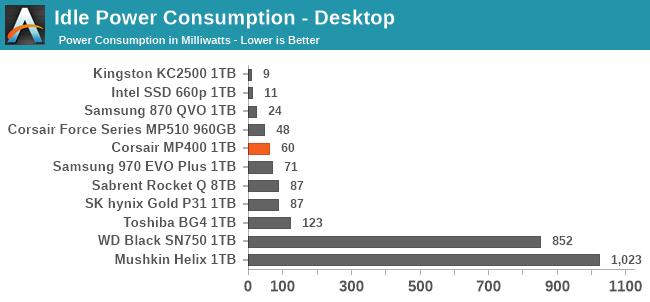
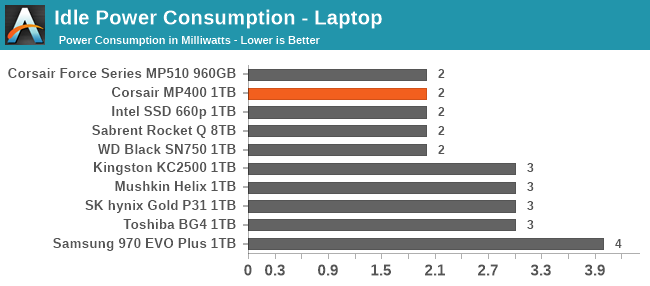
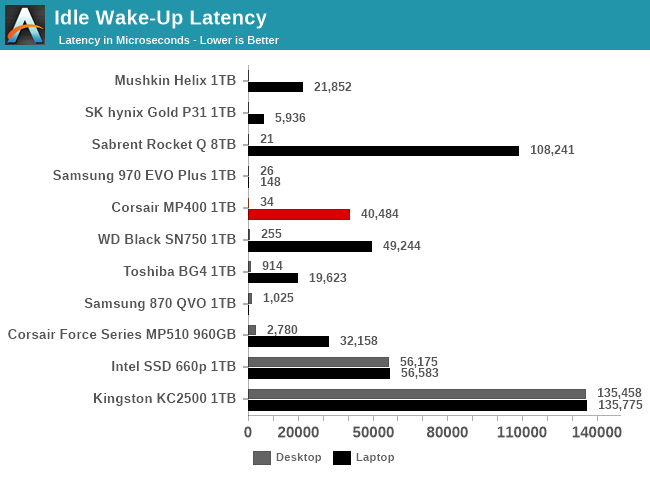
The Corsair MP400 identifies itself as having the same idle power management capabilities as the Sabrent Rocket Q, and significantly lower maximum power draw in its active power states than the very pessimistic figures our 8TB Rocket Q sample provides to the OS.
The active and desktop idle power values we measured for the MP400 are a bit lower than for the Rocket Q 8TB, which is to be expected given the lower part count on the 1TB MP400. Waking up from the intermediate desktop idle state is extremely quick, but waking from the deepest sleep state is just a bit on the slow side.










75 Comments
View All Comments
DZor - Friday, December 11, 2020 - link
Today's drives have less and less endurance.This Corsair 1TB model just 200TBW
For example Samsung 860 EVO is 600TBW!!!! Three times longer!!!
rozquilla - Friday, December 11, 2020 - link
Agree, it is an almost disposable storage device. On the other hand an average office/web user will not reach this level of writes for years, but somebody using NVMe drives in RAID for content creation will need to have like an ammo box of these drives nearby to keep swapping drives.Tomatotech - Friday, December 11, 2020 - link
Maybe, maybe this type of drive, at this price point, isn't aimed at 'content creators'. Anyone earning a living off content creating is going to be using rather more expensive tools. Looks perfectly fine for the average user.In the recent Anandtech review of the QLC 8TB nvme drive, I was really quite impressed the way the 8TB drive leveraged its vast storage space to overcome many of the QLC limitations. It was able to use up to 2TB as high speed SLC-level cache. Many people will rarely move more than 1 or 2 TB in a single operation.
Looking forward to 8TB QLC+ drives dropping to mortal prices.
danbob999 - Monday, December 14, 2020 - link
The thing is, is that drive is 7 TB full, you don't get that same 2 TB cache. There is likely at most 256 GB left.TheinsanegamerN - Tuesday, December 15, 2020 - link
And how many users are going to move 256GB at once?at_clucks - Wednesday, December 16, 2020 - link
You're asking the wrong question. What happens when you have a full drive (like most regular users end up doing because data tends to cruft up in there), and now you juggle all your operations in the little space you have free? Sure, wear leveling you might say but again, in an SSD with sub-mediocre performance AND endurance that will not go well because that's a lot of data you move around to do wear leveling. Keep in mind that wear leveling isn't about getting lower total wear but rather getting uniform wear and spread out concentration of write cycles (it actually increases wear by write amplification). Eventually the drive, depending on how its WL algorithms work, will start moving the long stationary data around to the blocks that were used more, in order to write the more dynamic data to those "pristine" blocks. *All* of that data has to be constantly shuffled for the WL to work as expected. That's how WL and garbage collection work and it's great when you have a lot of free space and basically treat it as a small drive with 7TB to spare to make up for shitty QLC.You can't get something from nothing, having a lot of space makes the issue "less obvious" to the user, not "non-existent", and only if it's free. The issue is still there. The free space kept free is the price you pay for having a working drive. Like a CPU with 32 cores but you can never use more than 12 because they will out.
Maverick009 - Friday, December 11, 2020 - link
Even content creators do not have to worry as much, plus the serious ones still use Mechanical Hard drives, but usually the NAS quality ones like the IronWolf/Pro drives due to storage space per cost still being greatly cheaper. The SSD will be mainly used for the OS and applications to launch from, with a few using an SSD as a scrub drive, or RAID several mechanical drives together and use an SSD as a cache drive between them moving data much faster, while having also having the benefits of large storage.Beaver M. - Saturday, December 12, 2020 - link
No. You need a fast SSD when editing. A HDD is only useful for archiving anymore.niva - Wednesday, December 16, 2020 - link
Seriously, did you even read his comment?Beaver M. - Friday, December 18, 2020 - link
What? Youre acting as if what he claimed is any proof.